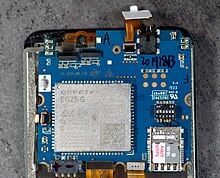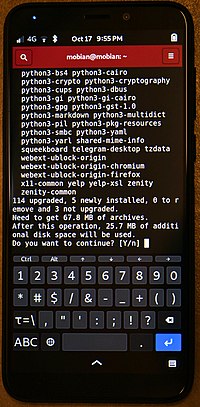PinePhone
This article's tone or style may not reflect the encyclopedic tone used on Wikipedia. (August 2024) |
 A PinePhone with the Plasma Mobile interface | |
| Brand | Pine64 |
|---|---|
| First released | January 2020 |
| Successor | PinePhone Pro |
| Dimensions | 160.5mm x 76.6mm x 9.2mm[1] |
| Weight | 185 grams[2] |
| Operating system | Linux |
| CPU | Allwinner A64 ARM Quad core Cortex-A53, 64bit @ max1.2GHz |
| GPU | Mali-400 MP2[3] |
| Modem | Quectel EG25-G, integrated |
| Memory | 2 or 3 GB LPDDR3[3] |
| Storage | 16 or 32 GB eMMC flash memory[3] |
| Removable storage | bootable microSD[3] |
| Battery | 3000mAh, Samsung J7 form-factor, user-replaceable (est. cost $10 US)[4] |
| Rear camera | Single OV5640, 5MP, 1/4″, LED Flash |
| Front camera | Single GC2145, 2MP, f/2.8, 1/5″ |
| Display | 720×1440 5.95″ IPS LCD[3] |
| Connectivity | Wi-Fi 802.11 b/g/n, single-band, hotspot capable, Bluetooth 4, A2DP, 3.5mm headphone jack, USB-C USB 2.0 PD/DisplayPort |
| Data inputs | sensors: Other
|
The PinePhone is a smartphone developed by Hong Kong–based computer manufacturer Pine64, designed to provide users with full control over the device. This is achieved through the utilization of mainline Linux-based mobile operating systems, assembly of the phone using screws, and facilitating simplified disassembly for repairs and upgrades.[5] The 2G-4GLTE modem,[6] GPS, Wi-Fi, Bluetooth and both cameras can be physically switched off.[7] The PinePhone ships with the Manjaro Linux operating system using the Plasma Mobile graphic interface, although other distributions can be installed by users.
History
[edit]Pine64 sold limited editions of the PinePhone, marketed towards developers and early adopters. The phone shipped worldwide with few geographical restrictions. The "Braveheart" edition, shipped in January 2020, was the first publicly available version of the phone, providing only a test firmware, so the user could test their phone before installing their operating system of choice.[8]
In 2019, Pine64 partnered with existing and well established Linux-on-phone projects to launch a "Community Edition" campaign to incentivize software development for the device.[9] Through this partnership, Pine64 donated $10 for each unit sold to the project maintainers. The community edition PinePhones featured a branding on the back cover and shipped with a custom box designed by the partnered artists. The "Mobian" community edition in February 2021 was the last to be offered.[10]

Initially, the PinePhone was only available in one hardware configuration. The enhanced "Convergence Package" was introduced with the postmarketOS community edition announcement, featuring increased RAM, additional eMMC storage, and a USB-C dock known as a "docking bar". The docking bar is capable of delivering power to the phone via USB-C power-in (3 A 5 V), outputting digital video via HDMI, and has 10/100 Mbit/s Ethernet connectivity and two USB 2.0 ports (for example, external storage, mouse and keyboard).[11]
In February 2021, Pine64 announced the end of community edition devices,[12] and that the default operating system for the production-ready PinePhone would be Manjaro using the KDE Plasma Mobile graphical environment.[13] The company then introduced the PinePhone Beta Edition several weeks later.[14] The Beta Edition's hardware and pricing was confirmed to be the same as the previous three community edition production runs, and the "Beta" was a reference to the software only. Pine64 began pre-orders on March 24, 2021, and began shipping Beta Edition devices in late April.
In October 2021, Pine64 announced the PinePhone Pro.[15] In January 2022, Pine64 started accepting pre-orders of PinePhone Pro for deliveries by February 2022.[16]
Features and comparisons
[edit]The PinePhone is often compared to other phones shipping with non-Android Linux distributions, especially the Librem 5, which released around the same time, and the WiFi-VoIP phone Necuno, which does not employ a cellular modem.
Pine64 promises five years of production. The long production life and sharing a common A64 platform with the PineTab tablet and Pine A64 boards is meant to encourage tinkerers to create mods and DIY projects based on the PinePhone.
Hardware
[edit]

The original PinePhone used an Allwinner A64 processor, which has four Cortex-A53 cores clocked at 1.152 GHz and a Mali-400 MP2 GPU. Its frame and case cover are made of plastic. It has a 5-megapixel back camera and a 2-megapixel front camera, and a USB-C port with USB 2.0 that supports DisplayPort alt-mode. The 3000 mAh battery supports 15 W fast charging and is easily replaced without tools. It uses the same form factor as a Galaxy J7 battery to make it easier to find replacement batteries.[17] Linux distributions configure its LPDDR3 DRAM at clock rates that vary between 552 and 624 MHz.[18]
Like the Librem 5, the PinePhone uses separate cellular baseband and Wi-Fi/Bluetooth chips. Together with the hardware kill switches, this results in larger printed circuit boards (PCBs) and less energy efficiency compared to the mass-produced Android phone that has an integrated System on a Chip, such as the Snapdragon, Helio or Exynos. The PinePhone is thinner at 9.2 mm than the Librem 5 which is 15.5 mm thick because the PinePhone solders its wireless communication chips to the PCB whereas the Librem 5 places the cellular baseband and Wi-Fi/Bluetooth on two removable M.2 cards.[1][19][20]
Pine64 is the second phone maker (after OpenMoko) to offer booting from a microSD card, which allows users to try out one or more operating systems before installing in the internal flash memory.
Another distinctive feature of the PinePhone is the I2C connector under the back cover, which can be used for adding mods to the phone.[21] In 2019 and 2020, Pine64 stated that it was developing four mods: a Psion Series 5-inspired physical keyboard,[22] a 5000 mAh battery, wireless charging[23] and a fingerprint sensor.[24]
The PinePhone has six DIP switches under the back cover, the first five of which switch off separately the cellular modem, the Wi-Fi/Bluetooth module, the microphone, the rear camera, and the front camera. The sixth DIP switch will convert the 3.5 mm headphone jack into a UART serial port,[21] which is the first time this kind of switch has been included in a mobile phone.[citation needed]
Circuit schematics of the PinePhone are available.[25]
Software
[edit]
The PinePhone aims to be fully open source in its drivers and bootloader. Despite this, due to the scarcity of open-source components for cellular and wireless connectivity, the firmware for the Realtek RTL8723CS Wi-Fi/Bluetooth, as well as the optional autofocus firmware for the OmniVision OV5640 back camera, remain proprietary software. In order to mitigate potential threats to privacy, these components communicate with the rest of the system only over serial protocols, such as USB 2.0, I2S and SDIO, which do not allow direct memory access (DMA). Use of these protocols also permits them to be physically disconnected via kill switches.[26]
In late 2020, Pine64 started an incentive called the Nutcracker Challenge, in order to encourage the development of open-source wireless networking on the BL602 Wi-Fi and Bluetooth board.[27] Some distributions support the use of USB Wi-Fi adapters that use open-source wireless firmware.[28] Modem firmware of the Quectel EG25-G LTE board is based on a proprietary Android userspace, though an unofficial, mostly open-source version exists, replacing most proprietary components, except for the baseband firmware and the TrustZone kernel, which is signed by Qualcomm.[29]
Operating systems
[edit]The PinePhone relies completely on open-source operating systems developed by external communities, with only the flashing onto the phone done by Pine64 directly.[30] Because these community OS projects were involved in the development of the PinePhone, it has been ported to 19 Linux distributions and seven graphical user interfaces, as of August 2021,[31] such as Ubuntu Touch by UBports, postmarketOS, Mobian (Debian ARM), LuneOS, Nemo Mobile and Maemo Leste.
An unofficial porting project, GloDroid, has ported Android 11 to the PinePhone.[32]
Difference between PinePhone Community Edition and PinePhone Pro, and controversy
[edit]Until 2021, the PinePhone had ports from several Linux Mobile distributions. These ports allowed for an easy installation process (flashing the distribution onto a bootable microSD card) which was convenient to both users and creators of the distributions. Official Community Editions were released with special branding for five projects: postmarketOS, UBPorts, KDE Plasma Mobile, Manjaro and Mobian. A portion of revenue from each of these branded editions would be passed on by Pine64 to the respective project.
In 2021, the PinePhone Pro appeared. This model came with controversial changes that caused one of the main PinePhone engineers to leave the project:[33]
- The PinePhone Community Edition programme was discontinued in favour of the PinePhone Pro.
- Instead of the several Linux distributions supported earlier, focus was given only to Manjaro, whose contributions to the mobile Linux ecosystem were allegedly minimal, and largely limited to packaging rather than creating or improving new software.
- The installation process changed from simple microSD flash card into a specific U-Boot-based process. This required other distros to adapt to the new model, redesigned with only Manjaro Mobile in mind, in order to be able to run on the PinePhone
- PinePhone staff began discussing changes and making decisions with only Manjaro in mind, rather than taking other Linux distributions into account.
The above choices have later been justified by Pine64, responding to the former engineer's blog post[34] as well as criticism of the PinePhone Pro by various Open Source communities.
Editions
[edit]| Model | Pre-installed OS | Pre-installed graphical interface | Pre-order date | Shipping date | Hardware revision | Processor | RAM (GB) | eMMC storage (GB) | Price |
|---|---|---|---|---|---|---|---|---|---|
| Pinephone - Braveheart Edition[8] | Factory Test image based on postmarketOS | custom UI | November 15, 2019[35] | January 17, 2020[3] | v1.1 | Allwinner A64 ARM Quad core Cortex-A53, 64bit @ max1.2 GHz | 2 | 16 | $149 |
| Pinephone - UBports Community Edition[36] | Ubuntu Touch | Lomiri | April 2, 2020[36] | May 2020 | v1.2 | ||||
| Pinephone - postmarketOS Community Edition[37] | postmarketOS | Phosh | July 15, 2020[38] | August 25, 2020 | v1.2a | 2/3 | 16/32 | $149 / $199 (latter includes USB-C dock) | |
| Pinephone - Manjaro Community Edition[39] | Manjaro | Phosh[40] | September 17, 2020[39] | October 30, 2020 | v1.2b | ||||
| Pinephone - KDE Community Edition[41] | Manjaro (customized version)[42] | Plasma Mobile | December 1, 2020[41] | January 2021 | |||||
| Pinephone - Mobian Community Edition[43] | Mobian | Phosh | January 17, 2021[43] | February 2021 | |||||
| Pinephone - Beta Edition[14] | Manjaro | Plasma Mobile | March 24, 2021[44] | April 2021 | |||||
| Pinephone Pro - Explorer Edition[45] | Manjaro | Plasma Mobile | 2022 | 2022 | Rockchip RK3399S SoC with 2× 1.5 GHz A72 cores and 4× 1.5 GHz A53 cores | 4 | 128 | $399 |
List of Operating systems that can run on PinePhone
[edit]Reception
[edit]In August 2020, AndroidPolice reviewed the first Community edition, and beside the title "The Linux-based PinePhone is the most interesting smartphone I've tried in years" it touted the number of available distros, and the idea behind communities being provided with the means of developing their OS.[46]
In January 2020, ZDNet called the PinePhone hardware "promising" and noted the hardware switches.[47]
In December 2019, Martins D. Okoi of FossMint said that the first edition of the PinePhone is aimed at Linux-savvy users who would like to test beta operating system builds, but the version for general users should be available in March 2020.[48]
In November 2019, Phillip Prado of Android Authority said that the PinePhone had the potential to "expand our imaginations into what mobile computing could look like", but he was not expecting it to replace everyone's Android device.[49] Ars Technica wrote about the unusual external ports of the phone, offering I2C, GPIO and serial.[3]
See also
[edit]References
[edit]- ^ a b "The $149 Linux Phone: Everything You Need to Know". OMG! Ubuntu!. 8 November 2019.
- ^ Aufranc, Jean-Luc (16 July 2020). "Pinephone "Community Edition: PostmarketOS" Launched with 3GB RAM, 32GB Flash, USB-C Hub". CNX Software - Embedded Systems News.
- ^ a b c d e f g Amadeo, Ron (2020-01-16). "The PinePhone starts shipping—a Linux-powered smartphone for $150". Ars Technica. Retrieved 2020-01-20.
- ^ a b "PINEPHONE". PINE64.
- ^ "September Update: The PinePhone is real & shipping soon". PINE64. 5 September 2019. Retrieved 2020-01-15.
- ^ "LTE EG25-G Specifications". 2024-09-14.
- ^ T., Raffaele (2 September 2019). "Librem 5 vs. PinePhone: comparison of two Linux smartphones". TuxPhones.
- ^ a b "November Update: Brave Heart, Pinebook Pro reception and more". Pine64. 5 November 2019. Retrieved 24 July 2021.
- ^ Erecinski, Lukasz (August 19, 2019). "Its time to start giving back". Archived from the original on January 21, 2021.
- ^ Lukasz, Erecinski (January 15, 2021). "January Update: Happy New Gear!". pine64. Archived from the original on January 16, 2021.
- ^ Erecinski, Lukasz (July 15, 2020). "July Update: biggest update in months!". Archived from the original on January 21, 2021.
- ^ Erecinski, Lukasz (February 2, 2021). "The end of Community Editions". Pine64. Retrieved April 23, 2021.
- ^ Sneddon, Joey (February 16, 2021). "PinePhone Picks a Default OS — But Not the One I Expected". OMG! Ubuntu!. Retrieved April 23, 2021.
- ^ a b Erecinski, Lukasz (March 15, 2021). "March Update: Status Report". Pine64. Retrieved April 23, 2021.
- ^ "October Update: Introducing the PinePhone Pro". PINE64. 15 October 2021. Retrieved 2021-10-25.
- ^ "PinePhone Pro Explorer Edition pre-orders open January 11". PINE64. 11 January 2022. Retrieved 2022-01-13.
- ^ amosbatto (2019-08-25). "Comparing specs of upcoming Linux phones". Purism forum.
- ^ devrtz (2020-05-12). "[Volunteer needed]Too high DRAM clock speed MAY be causing you random crashes/freezes". Pine64 forum.
- ^ Amadeo, Ron (2019-09-26). "Purism's Librem 5 phone starts shipping—a fully open GNU/Linux phone". Ars Technica. Retrieved 2019-10-08.
- ^ "Librem 5 Update: Fresh Dogwood Pictures". Purism. 2020-05-21. Retrieved 2020-06-24.
- ^ a b "PinePhone". pine64.org wiki. Retrieved 26 June 2020.
- ^ "December Update: Thank You For 2019!". PINE64. 5 December 2019.
- ^ "May Update: PineTab pre-orders, PinePhone Qi charging & more!". PINE64. 15 May 2020.
- ^ "December Update: The Longest One Yet". PINE64. 15 December 2020.
- ^ PINE64 (2020-10-11). "PinePhone v1.2b Released Schematic" (PDF).
{{cite web}}: CS1 maint: numeric names: authors list (link) - ^ Erecinski, Lukasz (26 January 2020). "Setting the Record Straight: PinePhone Misconceptions". pine64.org official Pine64 homepage.
- ^ "Nutcracker Challenge: Blob-Free WiFi & BLE". PINE64. 28 October 2020. Retrieved 2021-12-10.
- ^ "How about a more libre PinePhone with atk9k_htc?". LINux on MOBile. 27 November 2022. Retrieved 2023-01-20.
- ^ By (2022-07-12). "Open Firmware For PinePhone LTE Modem – What's Up With That?". Hackaday. Retrieved 2022-09-11.
- ^ Aufranc, Jean-Luc (16 November 2019). "PinePhone "Braveheart" Limited Edition Linux Smartphone is Now Available for $150". CNX Software - Embedded Systems News.
- ^ "PinePhone Software Releases". pine64.org wiki. Retrieved 6 August 2021.
- ^ "GloDroid Brings Android 10 OS to Raspberry Pi 4, Orange Pi SBC's, PinePhone, and PineTab - CNX Software". CNX Software - Embedded Systems News. 2020-07-15. Retrieved 2021-12-10.
- ^ "Why I left PINE64". BrixIT Blog. 2022-08-17. Retrieved 2024-07-30.
- ^ "A response to Martijn's blog". pine64.org. 2022-08-18. Retrieved 2024-07-30.
- ^ "PinePhone Linux smartphone pre-orders start next week". SlashGear. 7 November 2019.
- ^ a b "PINEPHONE – "Community Edition: UBports" Limited Edition Linux SmartPhone $149.99". Pine64. Archived from the original on 2020-05-31. Retrieved 2020-04-03.
- ^ "June Update: postmarketOS CE PinePhone, Shipping & PINE64 Cluster". Pine64. 15 June 2020.
- ^ "postmarketOS". July 17, 2020. Archived from the original on December 23, 2020. Retrieved January 20, 2021.
- ^ a b "September Update: Let it sink in…". PINE64. 15 September 2020. Retrieved 2020-09-18.
- ^ "Which interface was pre-installed on the PinePhone CE: Manjaro?". PINE64 Forum. 2021-08-03.
- ^ a b "KDE Community Edition is now available | PINE64". December 1, 2020. Archived from the original on January 3, 2021.
- ^ "PinePhone: KDE community edition". plasma-mobile.org. December 1, 2020. Archived from the original on January 28, 2021.
- ^ a b Erecinski, Lukasz (January 17, 2021). "Mobian Community Edition". pine64. Archived from the original on January 20, 2021.
- ^ Erecinski, Lukasz (March 19, 2021). "Beta Edition Pre-Orders". Pine64.
- ^ "PinePhone Pro Explorer Edition". PINE STORE. Retrieved 2022-04-07.
- ^ "The Linux-based PinePhone is the most interesting smartphone I've tried in years". AndroidPolice. 2020-08-13. Retrieved 2020-08-13.
- ^ Leprince-Ringuet, Daphne. "This Linux smartphone is now shipping for $150". ZDNet. Retrieved 2020-01-20.
- ^ Okoi, Martins D. (2019-12-19). "PinePhone - An Open Source Smart Phone for Everyone". Retrieved 2020-01-15.
- ^ Prado, Phillip (2019-11-28). "PinePhone: Everything you need to know about the $150 Linux-powered phone". Android Authority. Retrieved 2020-01-15.

